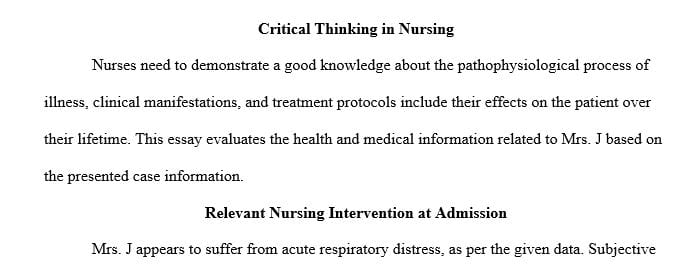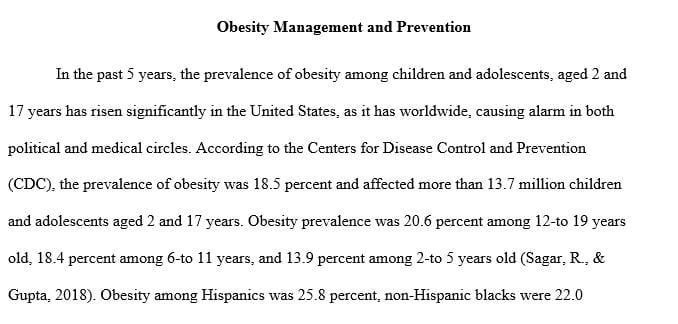Understanding of the pathophysiological processes of disease, the clinical manifestations and treatment protocols.
It is necessary for a nurse to demonstrate an enhanced understanding of the pathophysiological processes of disease, the clinical manifestations and treatment protocols, and how they affect clients across the life span.
Evaluate the Health History and Medical Information for Mrs. J., presented below.
Based on this information, formulate a conclusion based on your evaluation, and complete the Critical Thinking Essay assignment, as instructed below.
Health History and Medical Information
Health History
Mrs. J. is a 63-year-old married woman who has a history of hypertension, chronic heart failure, and chronic obstructive pulmonary disease (COPD). Despite requiring 2L of oxygen/nasal cannula at home during activity, she continues to smoke two packs of cigarettes a day and has done so for 40 years. Three days ago, she had sudden onset of flu-like symptoms including fever, productive cough, nausea, and malaise. Over the past 3 days, she has been unable to perform ADLs and has required assistance in walking short distances. She has not taken her antihypertensive medications or medications to control her heart failure for 3 days. Today, she has been admitted to the hospital ICU with acute decompensated heart failure and acute exacerbation of COPD.
Subjective Data
Is very anxious and asks whether she is going to die.
Denies pain but says she feels like she cannot get enough air.
Says her heart feels like it is “running away.”
Reports that she is exhausted and cannot eat or drink by herself.
Objective Data
Height 175 cm; Weight 95.5kg.
Vital signs: T 37.6C, HR 118 and irregular, RR 34, BP 90/58.
Cardiovascular: Distant S1, S2, S3 present; PMI at sixth ICS and faint: all peripheral pulses are 1+; bilateral jugular vein distention; initial cardiac monitoring indicates a ventricular rate of 132 and atrial fibrillation.
Respiratory: Pulmonary crackles; decreased breath sounds right lower lobe; coughing frothy blood-tinged sputum; SpO2 82%.
Gastrointestinal: BS present: hepatomegaly 4cm below costal margin.
Intervention
The following medications administered through drug therapy control her symptoms:
IV furosemide (Lasix)
Enalapril (Vasotec)
Metoprolol (Lopressor)
IV morphine sulphate (Morphine)
Inhaled short-acting bronchodilator (ProAir HFA)
Inhaled corticosteroid (Flovent HFA)
Oxygen delivered at 2L/ NC
Critical Thinking Essay
In 750-1,000 words, critically evaluate Mrs. J.’s situation. Include the following:
Describe the clinical manifestations present in Mrs. J.
Discuss whether the nursing interventions at the time of her admissions were appropriate for Mrs. J. and explain the rationale for each of the medications listed.
Describe four cardiovascular conditions that may lead to heart failure and what can be done in the form of medical/nursing interventions to prevent the development of heart failure in each condition.
Taking into consideration the fact that most mature adults take at least six prescription medications, discuss four nursing interventions that can help prevent problems caused by multiple drug interactions in older patients. Provide a rationale for each of the interventions you recommend.
Provide a health promotion and restoration teaching plan for Mrs. J., including multidisciplinary resources for rehabilitation and any modifications that may be needed. Explain how the rehabilitation resources and modifications will assist the patients’ transition to independence.
Describe a method for providing education for Mrs. J. regarding medications that need to be maintained to prevent future hospital admission. Provide rationale.
Outline COPD triggers that can increase exacerbation frequency, resulting in return visits. Considering Mrs. J.’s current and long-term tobacco use, discuss what options for smoking cessation should be offered.
You are required to cite to a minimum of two sources to complete this assignment. Sources must be published within the last 5 years and appropriate for the assignment criteria and relevant to nursing practice.
Prepare this assignment according to the guidelines found in the APA Style Guide, located in the Student Success Center. An abstract is not required.
This assignment uses a rubric. Please review the rubric prior to beginning the assignment to become familiar with the expectations for successful completion.
You are required to submit this assignment to LopesWrite. Refer to the LopesWrite Technical Support articles for assistance
nrs_410v__ass_1__rubric_print_format__15_
"Looking for a Similar Assignment? Get Expert Help at an Amazing Discount!"









